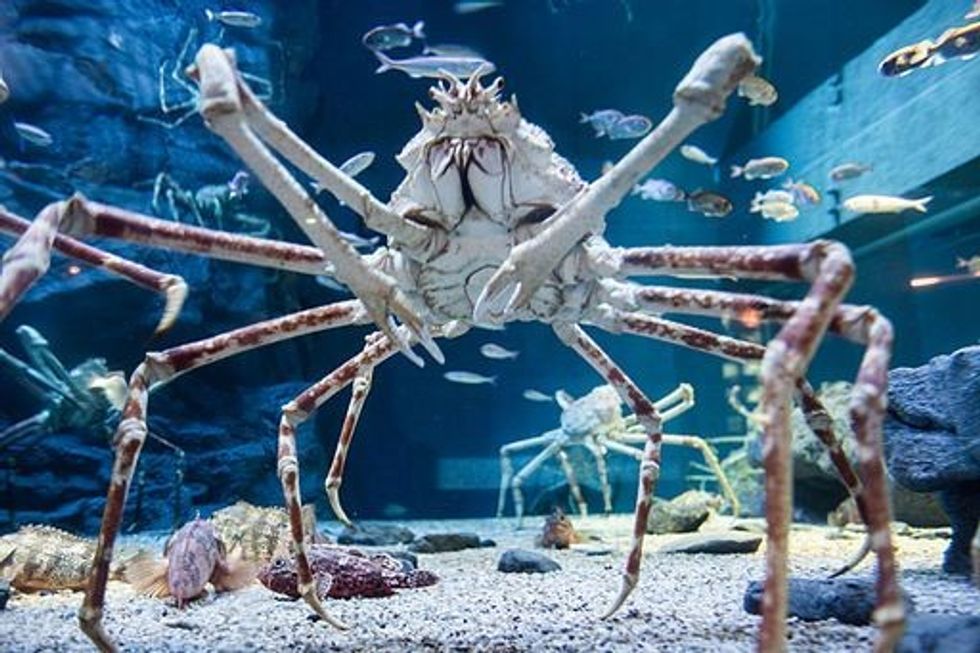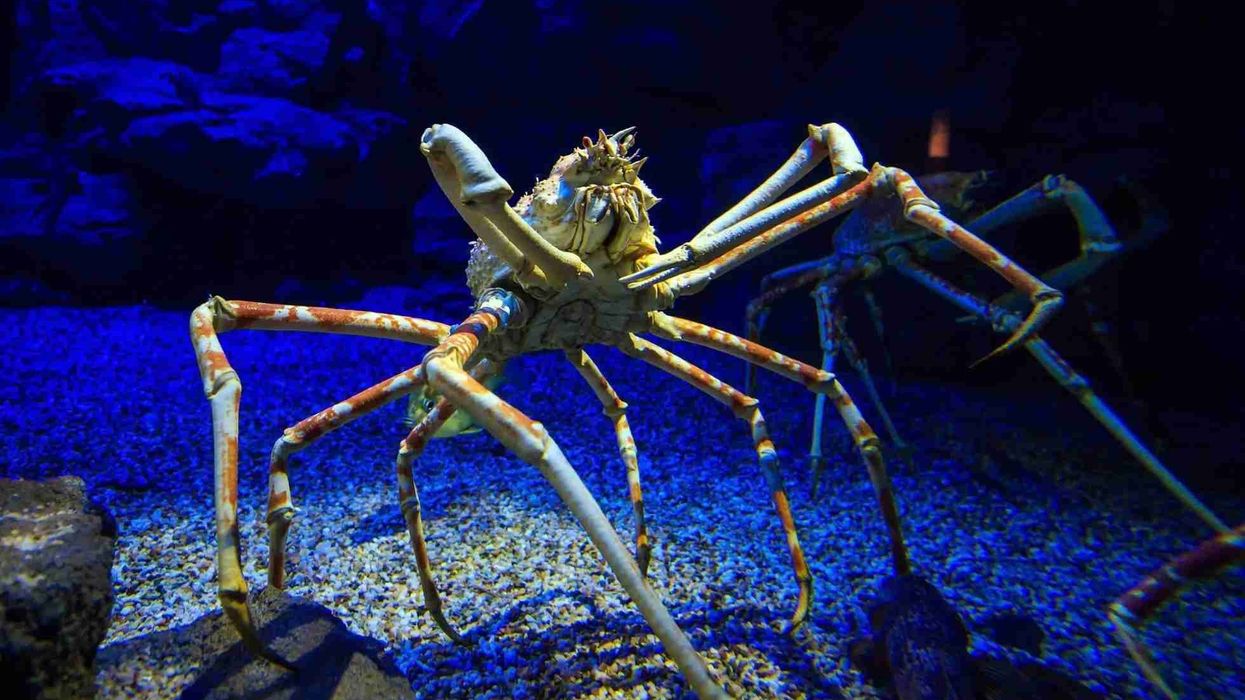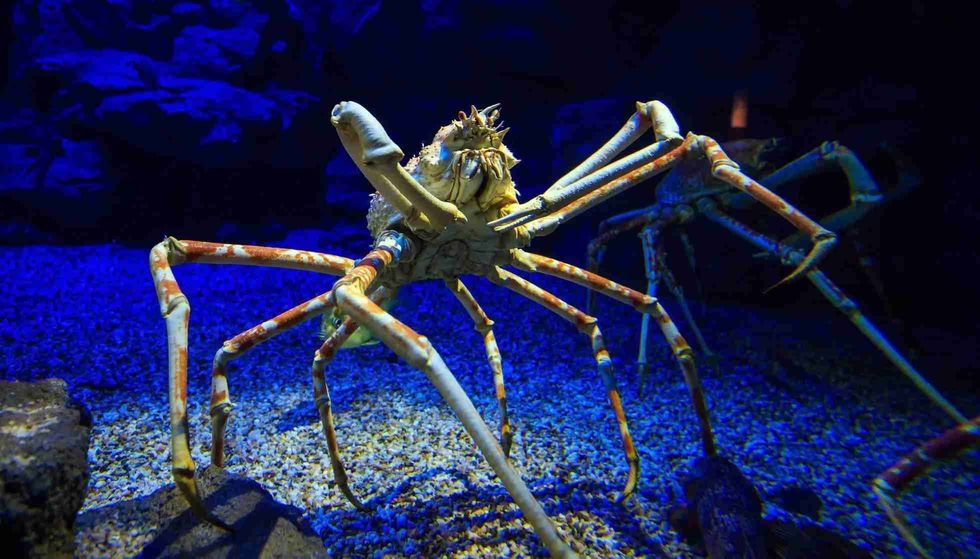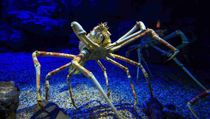Fun Japanese Spider Crab Facts For Kids
Japanese spider crabs, as the name suggests, are a species of crab that resemble enormous spiders. These arthropods are found near the Pacific shores of Japan.
They are considered to be one of the largest arthropods. But even though they grow to an enormous size (bigger than an average human), they are quite docile in nature. They are in fact a little lazy as well.
They are not known for their predatory skills and survive instead as a scavenger. These crabs can not defend themselves well and choose to use camouflage as a way to protect themselves.
Japanese Spider Crabs are considered to be a delicacy in Japanese cuisine. It is served on various occasions and festivals. In the last few decades, the fishing of Japanese spider crabs has increased manifold.
This has led the Japanese government to regulate its fishing and banning it entirely during the breeding season. These crabs require a very specific environmental condition to live in. This restricts its breeding elsewhere and is hence solely dependent on the natural population that lives around Japan.
You may also check out horseshoe crab facts and king crab facts from Kidadl.
Japanese Spider Crab Interesting Facts
What type of animal is a Japanese spider crab?
The Japanese spider crab as the name suggests is a type of crab that resembles a spider. It is one of the largest known arthropods (leg span wise) in the world. This species of marine crabs are found in the Pacific side of a number of Japanese islands.
The Japanese spider crab scientific name is Macrocheira kaempferi. This word has its origin in two Greek words.
The word Macrocheira can be broken into two parts: Makros (meaning big or long) and Cheir (meaning hands or arms). This nomenclature hence refers to the long and slender legs that this species of crab has. It was discovered in 1836 by Coenraad Jacob Temminck.
What class of animal does a Japanese spider crab belong to?
The Japanese spider crab (Macrocheira kaempferi) belongs to the class Malacostraca of the phylum Arthropoda.
How many Japanese spider crabs are there in the world?
The Japanese giant spider crab which is also called Taka-Ashi-Gani, (translates to tall legs crab) do not have a clear species count. This living arthropod is not considered endangered even though a large portion of its population has reduced due to overfishing in the last few decades.
The Japanese crab spider is known to lay a mammoth number of eggs (1.5 million per crab per season).
But all of these do not hatch leading to a far lesser amount of progenies. The specific geographical range and environmental requirement of the giant Japanese spider crab also restrict their propagation in the other parts world limiting its scope to populate further.
Where does a Japanese spider crab live?
The Japanese giant spider crabs (Macrocheira kaempferi) are commonly found in the Japanese bays of Sagami, Suruga, and Tosa. Their presence has also been recorded off the Kii peninsula and south of Su ao (eastern Taiwan).
What is a Japanese spider crab's habitat?
These giant spider crabs reside at a depth of about 492-984 ft (150 - 300 m) on the rocky and sandy continental shelf of the Japanese Pacific Ocean. But under some circumstances, they have also been seen to reside in shallower waters at a depth of about 1969 ft (600 m).
Then again these crabs travel to the shallower waters of the continental shelf during the spawning season and as a result, there is a higher density of its younger population in this range.
Who do Japanese spider crabs live with?
Japanese Spider Crab adaptations make them solitary beings. It has been seen that they do not communicate much with the other members of their species. Even though their population is concentrated in a niche area of the Pacific Ocean, they prefer to lead a simple, uneventful, and unsocial life.
The Japanese spider crab deep-sea creatures share their habitat with a number of other species of aquatic animals. These animals include frilled sharks, Atlantic wolffish, vampire squid, and Pacific viperfish. Many of these animals that cohabit pose a threat to these slow-moving, sedentary, scavenger crabs.
How long does a Japanese spider crab live?
Various researchers have seen that the Japanese spider crab's lifespan is about 100 years. But due to incessant fishing, the life span of these giant spider crabs can be drastically reduced. Japanese spider crab predators include larger marine creatures such as octopuses and stingrays.
How do they reproduce?
This giant spider crab species is known to mate during the spring (January to March). During this time, they travel to the shallower waters in their habitat.
The male crabs which have a store of sperms in their spermatophores (protein capsule containing sperms) insert it into a female's abdomen. They do this with the help of their first two chelipeds (the pair of long legs that have the pincer like claws).
Unlike other marine animals, the process of fertilization is internal in the Japanese spider crabs, taking place within the female's body. The female crab then carries the fertilized eggs in her abdominal appendages.
These females are known to lay about 1.5 million eggs per season but much fewer than this actually hatch. This process of hatching takes place after about 10 days of laying the eggs.
After hatching, the baby crabs do not have any feet and undergo multiple shedding phases. It is only after the natural Japanese spider crab molting that their gigantic limbs are formed.
What is their conservation status?
Not that the Japanese spider crab is extinct, but there is no clear data on the status of conservation of this species. Even then, it has been seen that the population of Japanese Spider Crabs has reduced drastically over the last few decades due to overfishing.
To combat this reduction in numbers, the Japanese government has put a ban on fishing these crabs during its mating season.
Japanese Spider Crab Fun Facts
What do Japanese spider crabs look like?

The Japanese spider crab can look quite ominous with its massive body of 16 in (40 cm) and huge Japanese spider crab legs 12.1 ft (3.7 m). But this appearance can be deceiving.
This orange arthropod with white spots is on the contrary a docile creature of the oceans. It is known to be a nocturnal being that mostly survives on the remains of other dead animals.
This reduces its requirement to predate and renders its generous size only to defend itself. On average, these giant spider crabs can weigh about 35.24-44.05 lb (16-20 kg).
How cute are they?
Japanese spider crabs look quite ferocious. They are far from being cute even though their temperament is quite docile.
There are accounts of Japanese spider crab attacks with sailors being dragged out of boats and down to the ocean floor by these crabs, but there is no evidence of such incidents. However, with them being scavengers, any incidence of a drowned sailor being devoured by a Japanese spider Crab bite could be possible.
Even though it looks scary, it is ineffective and incapable to cause any harm to humans. Their claws are used for opening the shells of animals they eat.
How do they communicate?
Japanese spider crabs are known to be solitary beings. They do not communicate much within their species. These crabs have been seen to gather their food alone unlike other marine animals that work in groups.
These crabs due to their lack of predatory behavior have reduced stalks on which their eyeballs are set. Their antennas are also underdeveloped and short. These characteristics point clearly towards their social and predatory behavior.
How big is a Japanese spider crab?
Japanese spider crabs are known to be the largest arthropods on the planet due to the giant Japanese spider crab size. They measure a whopping 12.1 ft (3.7 m) from one claw to the other and their body is of about 16 in (40 cm).
Their massive legs and comparatively smaller body gives them the appearance of a spider from which they derive their name. The Japanese spider crab size comparison between sexes is worth noting.
The males are known to have longer front legs than those of the females. The bodies of the female on the other hand are wider as compared to the males.
How fast can a Japanese spider crab run?
There isn't much information about how well the Japanese spider crabs can run. Even then, they are known to be slow and sedentary which also accounts for their dietary behavior. Organisms that do not hold mobility as one of their strengths often adapt to their environment and especially threats by developing other techniques like camouflaging.
How much does a Japanese spider crab weigh?
Being the biggest arthropod, the Japanese Spider Crab weighs an overwhelming 35.24-44.05 lb (16-20 kg). Their mass is mostly concentrated on their body as their legs are leaner.
What are the male and female names of the species?
There are no separate names given to the males and females of this species of crabs.
What would you call a baby Japanese spider crab?
Baby crabs, in general, are called zoea.
What do they eat?
Japanese spider crabs are mostly scavengers. The Japanese spider crab diet mostly consists of the dead and decaying remains of other aquatic animals. They are also omnivorous and like to eat algae, plants, and small fishes as well. Their dietary habit makes them less threatening as compared to other marine creatures.
These crabs don't eat humans and cannot kill humans but they can cause injury with their claws. They are not dangerous provided you don't provoke them. They are scavengers and can go for days without food.
Are they eaten by humans?
If you're wondering if the Japanese spider crab is edible or about the Japanese spider crab taste, yes, these crabs are considered a delicacy in Japan and are often hunted for their meat. They are used in different soups, sushi, and other Japanese dishes.
This crab meat is consumed during special occasions and is not a part of the regular diet.
Would they make a good pet?
Japanese spider crabs are not known to be kept as pets. Considering their large size and long legs it would require a huge tank and a regular supply of fresh ocean water.
These factors could make it an inconvenient pet to maintain. Even though these crabs have been kept in aquariums for the purpose of studying, they require extreme regulation of living conditions.
Did you know...
Adolescent Japanese spider crabs love to decorate themselves with shells, mollusks, and other small living creatures. These help them greatly to camouflage from their enemies as they by nature are not proactive defenders.
However, as they grow older and achieve their adult size, they stop this process of beautification. Common justifications for this change in behavior are either they become lazier or as they travel deeper into the ocean such objects are not easily available.
Some also argue that with their increase in size, their potential threats reduce. This gives them the freedom to live without the fear of being attacked.
Two fossilized species related to the Japanese spider crabs have been found. These belonged to the Miocene era (lasting 23.03-5.3 million years ago). These species are called Macrocheira ginzanensis and Macrocheira yabei.
What is the biggest Japanese spider crab ever on record?
The largest Japanese spider crab on record is Crabzilla, measuring over 12 ft (3.6 m) across at Scheveningen Sea Life center in The Hague, Netherlands (2010). At the age of 40, this crab with long legs weighs over 30 lb (13.6 kg).
How are Japanese spider crab populations protected?
To combat the reduction in their numbers, the Japanese government has put a ban on fishing these crabs during its mating season.
Here at Kidadl, we have carefully created lots of interesting family-friendly animal facts for everyone to discover! Learn more about some other arthropods from our green crab facts and sally lightfoot crab facts pages.
You can even occupy yourself at home by coloring in one of our free printable Japanese Spider Crab coloring pages.
We Want Your Photos!
More for You
Bachelor of Arts specializing in Linguistics

Martha MartinsBachelor of Arts specializing in Linguistics
Martha is a full-time creative writer, content strategist, and aspiring screenwriter who communicates complex thoughts and ideas effectively. She has completed her Bachelor's in Linguistics from Nasarawa State University. As an enthusiast of public relations and communication, Martha is well-prepared to substantially impact your organization as your next content writer and strategist. Her dedication to her craft and commitment to delivering high-quality work enables her to create compelling content that resonates with audiences.
Disclaimer
1) Kidadl is independent and to make our service free to you the reader we are supported by advertising. We hope you love our recommendations for products and services! What we suggest is selected independently by the Kidadl team. If you purchase using the Buy Now button we may earn a small commission. This does not influence our choices. Prices are correct and items are available at the time the article was published but we cannot guarantee that on the time of reading. Please note that Kidadl is a participant in the Amazon Services LLC Associates Program, an affiliate advertising program designed to provide a means for sites to earn advertising fees by advertising and linking to Amazon. We also link to other websites, but are not responsible for their content.
2) At Kidadl, we strive to recommend the very best activities and events. We will always aim to give you accurate information at the date of publication - however, information does change, so it’s important you do your own research, double-check and make the decision that is right for your family. We recognise that not all activities and ideas are appropriate for all children and families or in all circumstances. Our recommended activities are based on age but these are a guide. We recommend that these ideas are used as inspiration, that ideas are undertaken with appropriate adult supervision, and that each adult uses their own discretion and knowledge of their children to consider the safety and suitability. Kidadl cannot accept liability for the execution of these ideas, and parental supervision is advised at all times, as safety is paramount. Anyone using the information provided by Kidadl does so at their own risk and we can not accept liability if things go wrong.
3) Because we are an educational resource, we have quotes and facts about a range of historical and modern figures. We do not endorse the actions of or rhetoric of all the people included in these collections, but we think they are important for growing minds to learn about under the guidance of parents or guardians.







